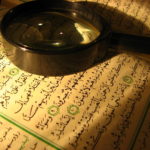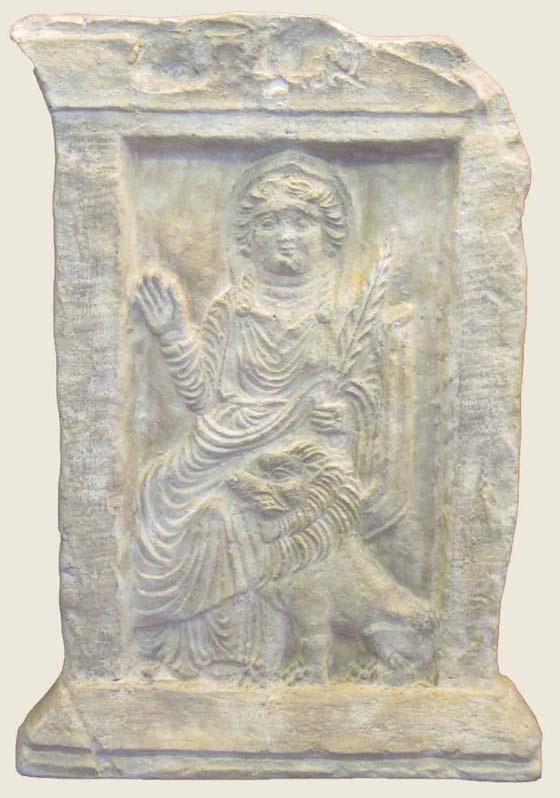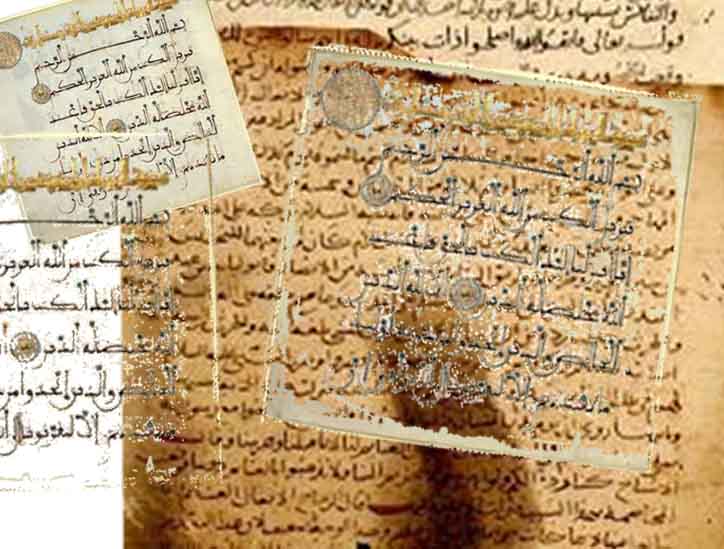
The text of the Qur’ān is that which exists between the covers of the established mushaf, while the tafsīr (‘commentary’) is a human attempt by an exegete to understand, explain, interpret and expound the Text according to his abilities, his learning, his religious affiliation, his priorities and interests. In such an exercise there is therefore inevitably some wheat and chaff, things that are useful and things that are injurious.
THERE IS MUCH that conflicts between the various commentators and their individual opinions and religious affiliations, to the point where some may impute to the Text that which it simply does not contain, or manoeuvre the Text forcibly to reflect their own views. By so doing the commentary cannot partake of the sanctity that the Text itself possesses. Instead it must be subjected to analysis, criticism and challenge.
For example, in his commentary on the following Qur’ānic passage:
And when thou saidst unto him on whom Allah hath conferred favour and thou hast conferred favour: Keep thy wife to thyself, and fear Allah. And thou didst hide in thy mind that which Allah was to bring to light, and thou didst fear mankind whereas Allah hath a better right that thou shouldst fear Him. So when Zayd had performed that necessary formality (of divorce) from her, We gave her unto thee in marriage[1]
al-Ālūsī records the tale of Zaynab bint Jahsh’s vision of the Prophet while she sat in her chamber grinding her perfume. He goes on to remark:
Glory be to the creator of light, blessed be God the best of creators! … Zayd her spouse was informed, he divorced her and she married the Prophet himself. This account was recorded direct from Qutāda, Ibn Jarīr accepted it, and Fakhr al-Dīn al-Rāzī did not dismiss it, although Ibn Zuhra and al-Dhahabī and others did reject it.
Similarly, Ibn Kathīr in his commentary on sūrat al-Najm reproduced Saʽīd ibn Jubayr’s account of al-Gharānīq (‘the exalted females’),[2] a tale which many others chose to reject. Ibn Jarīr and al-Qurtubī, in commenting upon the bearers of the throne,[3] remarked that
their feet were on the earth and their heads pierced the throne. From Kaʽb al-Ahbār it was related that when God created the throne it said: God shall not create a creature superior to me, and he shook himself (to show his glory) whereupon God caused a snake to circle him that had 70,000 wings, with each wing having 70,000 feathers and each feather 70,000 faces, and each face 70,000 mouths, and each mouth containing 70,000 tongues daily appearing from inside them to sing as many praises as there are drops of rain, trees, leaves, pebbles and particles of soil, as many days of this lower life and as many as all the angels. And the snake coiled itself around the throne, for the throne took up only half the size of the snake as it coiled about it.
Ibn Kathīr records that ‘Umar ibn al-Khattāb said to Kaʽb al-Ahbār “you must cease this prattling or I shall chase thee out unto the land of the apes.”
In his commentary on the verse: And verily We tried Solomon, and set upon his throne a (mere) body. Then did he repent (Qur’ān: XXXV,34), Ibn Jarīr recorded the account of the rebel who sat on the throne of Solomon maintaining dominion over Solomon’s wives, continuing to copulate with them whilst they were in a period of menstruation and while they abhorred this, all the while thinking that he was Solomon. Others also recorded the tale of the slaughter of the cow and the fashioning of the calf, or the story of God resting on the seventh day, or of His seat and His throne, in addition to providing descriptions of the jinn, the angels and devils. In among some of the well-known commentary works there are expositions on Qur’ānic tales such as Hārūt and Mārūt,[4] the story of the creation of Adam, or the account of the Ark and many other miraculous fables.
Many of these commentaries have inflicted considerable damage to the Nation
God’s reference to the ewe in: Lo! this my brother hath ninety and nine ewes while I had one ewe (Qur’ān: XXXVIII,23) is taken in the commentaries of al-Qurtubī and al-Jalālayn[5] to mean a woman, while the interpretation of: Men are in charge of women, because Allah hath made the one of them to excel the other (Qur’ān: V,34) is given as God having placed man in preference over the woman due to his being able to grow a moustache and a beard. Strange matters such as these, things entirely of the realm of fantasy, so occupied the minds of some commentators that one well-known editor was move to suggest that his commentary “has done everything except give an explanation of the Text.”
Likewise, Ibn Khaldūn in his Muqaddima spoke of confusion among the commentaries and their mutual contradictions concerning social and other factors deemed ‘religious,’ and noted that Arabs investigated more deeply into these questions whenever they could not find among themselves conducive explanations of such matters as the causes of creatures, or the time that creation began or the secrets of existence and other suchlike things. Instead they had recourse to the likes of Kaʽb al-Ahbār and Wahb ibn Munabbih[6] and ‘Abd Allāh ibn Salām[7] and story reciters when these gained influence over the mosques, to such a point that Ibn Qutayba was moved to say:
they attracted the attention of the masses and made a living out of things that were unknown or strange, or were lies or the product of hearsay.
Ahmad Amīn and Muhammad Rashīd Ridā severely criticised Wahb ibn Munabbih and Kaʽb al-Ahbār and others for having inserted the weird and the wonderful into the accounts reproduced in the commentaries.
Religious denominations and sects such as the Jahmiyya[8] and the Khawārij, the Ismāʽīlīs and the Kaysānīs[9] contributed to this process by interpreting Qur’ānic verses in such a way as to lend support to their factions and undermine those of others, while more esoteric factions turned the Qur’ān into a catalogue of obscure symbols and riddles far removed from any standard understanding or comprehension and from normal reality and life.
Esoteric factions ruled the Qur’ān into a catalogue of obscure symbols and riddles
In Ismāʽīlī Shīʽa commentaries, whenever the word sabʽa (‘seven’) occurs in the Qur’ān, such as at: We have given thee seven of the oft-repeated (verses)[10], or the “seven heavens”[11] or the “seven ears of grain”[12] or the “seven paths”[13] – it is held to denote the Seven Imāms. Meanwhile, among the Twelver Shīʽa[14] commentaries such as that by Ibn Ibrāhīm al-Qumī in the fourth hijrī century, or the al-Sāfī of Mullā Muhsin al-Kāshī in the 11th century, any mention of twelve months, heads, wells or tribes, is interpreted as denoting the Twelve Imāms. Among these commentaries, extreme interpretations vie to interpret references to ‘the hand’ of God, or to His power, His will, His words or His face as something denoting the infallible Imām, or they interpret al-Jibt and al-Tāghūt[15] as denoting the Caliphs, or that one rubʽ[16] of the Qur’ān refers to ʽAlī while another rubʽ refers to his enemies.
As for Jaʽfar al-Sādiq’s phrase: “We are the prayer, we are the fast, the Hajj, the sacred month, the sacred land, the Kaʽba and the Qibla,” or the ‘face of God’ in the Qur’ānic passage: and whithersoever ye turn, there is Allah’s Countenance (Qur’ān II,115), or the phrase “we are the verses, and we are the bayyināt” as recorded in the Kanz al-Fawā’id, or the phrase And ye will not, unless (it be) that Allah willeth (Qur’ān, LXXV,30 and LXXXI,29) – all these are interpreted in the commentaries by al-Qumī and Furāt as meaning the will of the Imāms. And as for the sentence: See they not how we visit the land, reducing it of its outlying parts? (Qur’ān XIII,41), the exposition given for it in al-Tabarasī’s Majmaʽ al-Bayān and al-Kulaynī’s Al-Kāfī is that it refers to the death of ‘Alī ibn Abī Tālib.
Commentators can be accepted or rejected since they are neither sacred nor infallible
Every mention of shirk[17] in the Qur’ān is made to refer to polytheism in ʽAlī’s state, so that the opponents of the imāmate must therefore be mushrikūn (‘polytheists’) according to the commentaries by al-Qumī, al-Burhān, Furāt and al-Sāfī. Meanwhile, the interpretation of: and let him make none sharer of the worship due unto his Lord (Qur’ān XVIII,110) is given as: “and let him make none sharer of the Caliphate with ʽAlī” when we read to the commentaries of al-ʽAyyāshī, al-Sāfī and al-Burhān. So the ‘disbeliever’ as mentioned in the Qur’ān becomes the disbeliever in ‘Alī’s imāmate, according to the commentaries of al-Qumī, al-ʽAyyāshī, and al-Burhān and the Mir’āt al-Anwār of al-‘Āmilī, in addition to al-Kāfī and al-Bihār, and many other commentaries besides.

Suggested Reading
It is clear from all this that it is vital to make a distinction between the Qur’ānic text as a sacred text and the various, conflicting commentaries that were subject to personal prejudices and factions, and to social, political and economic conditions. The fact remains that the words of commentators, as human beings, can be accepted or rejected since they are not sacred nor infallible.
Many of these commentaries have inflicted considerable damage to the Nation in their concepts, their doctrines and their culture, and this has had an influence in real life – in sowing dissension, fanaticism, ignorance and backwardness. All this calls for the reviewing, revision, investigation and refinement of the commentary works being published and disseminated in public.
[1] [Qur’ān XXX,37] The verse continues: so that (henceforth) there may be no sin for believers in respect of wives of their adopted sons, when the latter have performed the necessary formality (of release) from them. The commandment of Allah must be fulfilled. The context is that since Zaynab was the wife of Muhammad’s adopted son, pre-Islamic practices frowned upon her intended marriage with the Prophet, and the affair was used by critics of Muhammad to discredit him on two fronts: one of double standards as she was his fifth wife, while everyone else was restricted to four; and the other of marrying the wife of his adopted son. The revelation of this verse in the Qur’ān, however, confirmed that this marriage was valid. (Ed.)
[2] This is the question of the ‘Satanic verse’: tilk al-gharāniq al-ʽulā wa inna shafāʽatahunna turtadā (“These are exalted females whose intercession is to be desired”), said to have been once added to the Sūrat al-Najm: Have ye thought upon Al-Lāt and Al-ʽUzzā And Manāt, the third, the other? [Qur’ān LIII,19-20] – in order to acknowledge the validity of these three goddesses. (Ed.)
[3] [Qur’ān XL,7]: Those who bear the Throne, and all who are round about it, hymn the praises of their Lord.
[4] The names of two angels sent down to test the people of Babylon by performing deeds of magic, and seeing if they would heed the command not to imitate them. They appear in Qur’ān II,102: Solomon disbelieved not; but the devils disbelieved, teaching mankind magic and that which was revealed to the two angels in Babel, Harut and Marut. Nor did they (the two angels) teach it to anyone till they had said: We are only a temptation, therefore disbelieve not (in the guidance of Allah). (Ed.)
[5] That is, the Tafsīr al-Jalālayn or ‘The Commentary of the Two Jalāls,’ named after its two authors: Jalāl al-Dīn al-Mahallī (1389-1459) and his student Jalāl al-Dīn al-Suyūtī (1445-1505) who completed it. (Ed.)
[6] Wahb ibn Munabbih (ob. C.725 AD) is known for his work on ancient fantastic literature, including Qisas al-Anbiyā’ (‘Tales of the Prophets’) and Kitāb al-Isra’īlīyyāt (‘The Book of the Israelites’), collections of narratives concerning Biblical personages and Jewish folkloric stories. (Ed.)
[7] A companion of the Prophet Muhammad, said to have been a rabbi of aristocratic stock before his conversion to Islam. He is credited with authoring and indigenising within Islam a large corpus of Judaic traditions (Isrā’īlīyyāt). (Ed.)
[8] The tendency championed by Jahm ibn Safwān (ob.745) to deny every attribute mentioned in the scriptural texts, other than God’s attribute of creation and power, for fear of anthropomorphism. (Ed.)
[9] An early group of Shīʽa in Kufa taking their name from Abū ‘Amr Kaysān.
[10] Understood to be the opening sūrat al-Fātiha.
[11] [Qur’ān II,29]: He it is Who created for you all that is in the earth. Then turned He to the heaven, and fashioned it as seven heavens. And He is knower of all things.
[12] [Qur’ān XII,43]: (The Pharaoh addresses Joseph) And the king said: Lo! I saw in a dream seven fat kine which seven lean were eating, and seven green ears of corn and other (seven) dry. O notables! Expound for me my vision, if ye can interpret dreams.
[13] [Qur’ān XXIII,17]: And We have created above you seven paths.
[14] The term is derived from the doctrine of believing in twelve divinely ordained leaders, known as The Twelve Imams. It is the largest Shīʽa denomination of the contemporary period. (Ed.)
[15] That is, ‘idols and false gods’, from Qur’ān, IV,51.
[16] For memorization purposes the Qur’ān is divided into 30 equal parts, each called a juz’. Each juz’ is subdivided into two hizbs (‘sections’) which are further divided into four rubʽs (‘quarters’). (Ed.)
[17] See Glossary.
Main image: Sura 68 (Al-Qalam) from an Illuminated Mughal Qur’ān with interlinear Persian translation and commentary in the margin.


